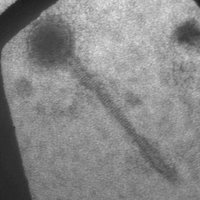Mycobacterium phage Dolus
Add or modify phage thumbnail images to appear at the top of this page.
Know something about this phage that we don't? Modify its data.
| Detailed Information for Phage Dolus | |
| Discovery Information | |
| Isolation Host | Mycobacterium smegmatis mc²155 |
| Found By | Lauren McKinley |
| Year Found | 2016 |
| Location Found | Bethlehem , PA USA |
| Finding Institution | Lehigh University |
| Program | Science Education Alliance-Phage Hunters Advancing Genomics and Evolutionary Science |
| From enriched soil sample? | Unknown |
| Isolation Temperature | Not entered |
| GPS Coordinates | 40.682455 N, 75.394238 W Map |
| Discovery Notes | The sample this phage originated from was adopted from another person within the class. Soil, from which the phage was first found, was collected January 17, 2016 in a winter climate. It was extracted from a depth of 1.73 inches in the ground, found beneath a dwarf burning bush hedges. When observed it was a very dry and cold soil seeing as how the temperatures would have been anywhere between 30-50 degrees Fahrenheit. |
| Naming Notes | This phages is named after the Greek God Dolos, connoisseur of tricks, lies, and deceptions. During purification this phage took on many appearances, having a small clear plaque at 24 hrs. and a halo around it at 48 hrs. At times it would even appear to clear a plat then grow over itself if very concentrated and left in the incubator for 48 hrs. Thus, purifying this sample proved exceedingly difficult since the phage had so many appearances. EM assisted in proving it was one phage, but it certainly has a knack for disguising itself and playing tricks on those who study it. Therefore, it is named after the best liar in history, Dolos. |
| Sequencing Information | |
| Sequencing Complete? | No |
| Genome length (bp) | Unknown |
| Character of genome ends | Unknown |
| Fasta file available? | No |
| Characterization | |
| Cluster | Unclustered |
| Subcluster | -- |
| Annotating Institution | Unknown or unassigned |
| Annotation Status | Not sequenced |
| Plaque Notes | This phage is a temperate phage, having two appearances that vary depending on incubation time. At twenty four hours it appears as a clear round plaque, about 1.0 mm in diameter. On any given plate there is a lot of diversity in growth, which proves to be different stages of maturation. Also it is fast growing, very infectious plaque capable of consuming an entire lawn on a bacterial plate. Perhaps the most interesting changes is noted after 48 hours in the incubator when it produces a halo around itself. This is a result of the phage leaving the plaque due to lack of bacteria and moving into the surrounding media in order to find more host to infect. In fact, if at high concentrations and almost no bacteria left, the phage will generates large plaques in the background on top of the older plaques. It appears like a different phage, but upon extensive research and purification it proved to be just another characteristic of the is phage. |
| Has been Phamerated? | No |
| Publication Info | |
| Uploaded to GenBank? | No |
| GenBank Accession | None yet |
| Refseq Number | None yet |
| Archiving Info | |
| Archiving status | Archived |
| SEA Lysate Titer | 8.0E10 |
| Date of SEA Lysate Titering | Apr 15, 2016 |
| Pitt Freezer Box# | 35 |
| Pitt Freezer Box Grid# | B8 |
| Available Files | |
| EM Picture | Download |
